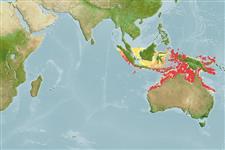Environment: milieu / climate zone / depth range / distribution range
Ökologie
seewasser riff-verbunden; tiefenbereich 40 - 80 m (Ref. 75154). Tropical; 4°N - 24°S, 91°E - 154°E (Ref. 55)
Eastern Indian Ocean: known only from a few specimens collected at Indonesia (off Sumatra and Sulawesi) and west of Kuri Bay, Western Australia.
Size / Gewicht / Alter
Maturity: Lm ? range ? - ? cm
Max length : 30.0 cm TL Männchen/unbestimmt; (Ref. 55)
Rückenflossenstacheln (insgesamt): 10; Rückenflossenweichstrahlen (insgesamt): 13-14; Afterflossenstacheln 3; Afterflossenweichstrahlen: 8 - 9. Snout somewhat pointed, dorsal profile of head sloping steeply. Preorbital bone relatively narrow, its width usually slightly less than eye diameter. Preopercular notch and knob poorly developed. Scale rows on back rising obliquely above lateral line. Generally red or pink when fresh; fins are red or orange. Juveniles under 10 cm SL have blackish caudal fin lobe tips, frequently also a crescentic blackish blotch in the middle of the caudal fin, sometimes also with a yellowish mid-lateral stripe extending from the rear edge of the operculum to the middle of the caudal fin.
Adults inhabit deeper reef areas. They occur solitarily or in small groups.
Life cycle and mating behavior
Geschlechtsreife | Fortpflanzung | Ablaichen | Eier | Fecundity | Larven
Allen, G.R., 1985. FAO Species Catalogue. Vol. 6. Snappers of the world. An annotated and illustrated catalogue of lutjanid species known to date. FAO Fish. Synop. 125(6):208 p. Rome: FAO. (Ref. 55)
IUCN Rote Liste Status (Ref. 130435)
Bedrohung für Menschen
Harmless
Nutzung durch Menschen
Fischereien: kommerziell
Mehr Information
NamenSynonymeMetabolismusRäuberÖkotoxikologieFortpflanzungGeschlechtsreifeAblaichenSpawning aggregationFecundityEierEientwicklung
ReferenzenAquakulturAquakultur ProfilZuchtlinienGenetikElectrophoresesVererbbarkeitKrankheitenVerarbeitungNutrientsMass conversion
PartnerBilderStamps, Coins Misc.LauteCiguateraGeschwindigkeitSchwimmstilKiemenoberflächeOtolithsGehirngrößeSehfähigkeit
Tools
Zusatzinformationen
Download XML
Internet Quellen
Estimates based on models
Preferred temperature (Ref.
123201): 25.9 - 27.9, mean 27.3 °C (based on 75 cells).
Phylogenetic diversity index (Ref.
82804): PD
50 = 0.5000 [Uniqueness, from 0.5 = low to 2.0 = high].
Bayesian length-weight: a=0.01479 (0.00706 - 0.03101), b=2.97 (2.81 - 3.13), in cm total length, based on LWR estimates for this Genus-body shape (Ref.
93245).
Trophic level (Ref.
69278): 3.8 ±0.6 se; based on size and trophs of closest relatives
Widerstandsfähigkeit (Ref.
120179): mittel, Verdopplung der Population dauert 1,4 - 4,4 Jahre. (Preliminary K or Fecundity.).
Fishing Vulnerability (Ref.
59153): Low vulnerability (20 of 100).
Nutrients (Ref.
124155): Calcium = 46.2 [30.7, 63.9] mg/100g; Iron = 0.374 [0.241, 0.560] mg/100g; Protein = 18.5 [17.0, 19.8] %; Omega3 = 0.151 [0.107, 0.208] g/100g; Selenium = 57.7 [39.0, 82.9] μg/100g; VitaminA = 170 [33, 621] μg/100g; Zinc = 0.486 [0.389, 0.671] mg/100g (wet weight);
